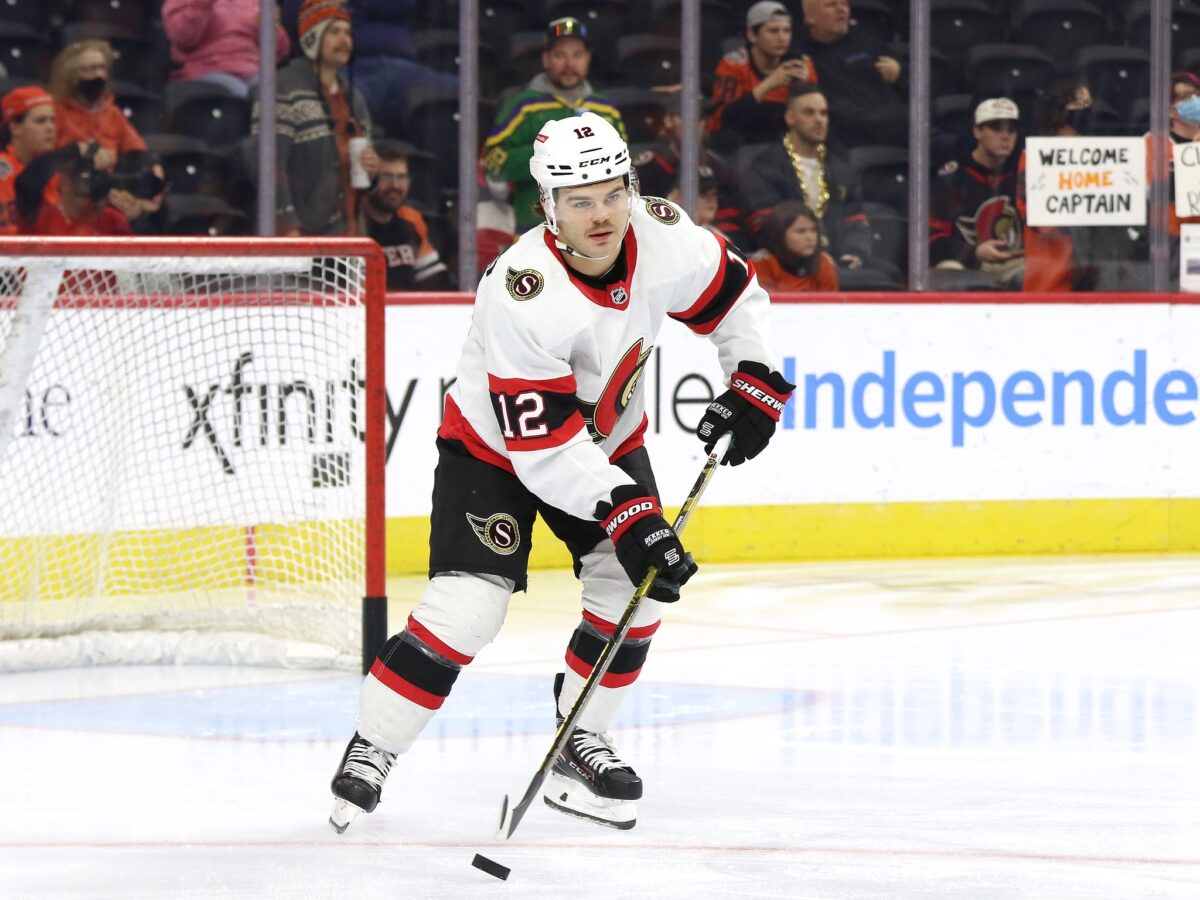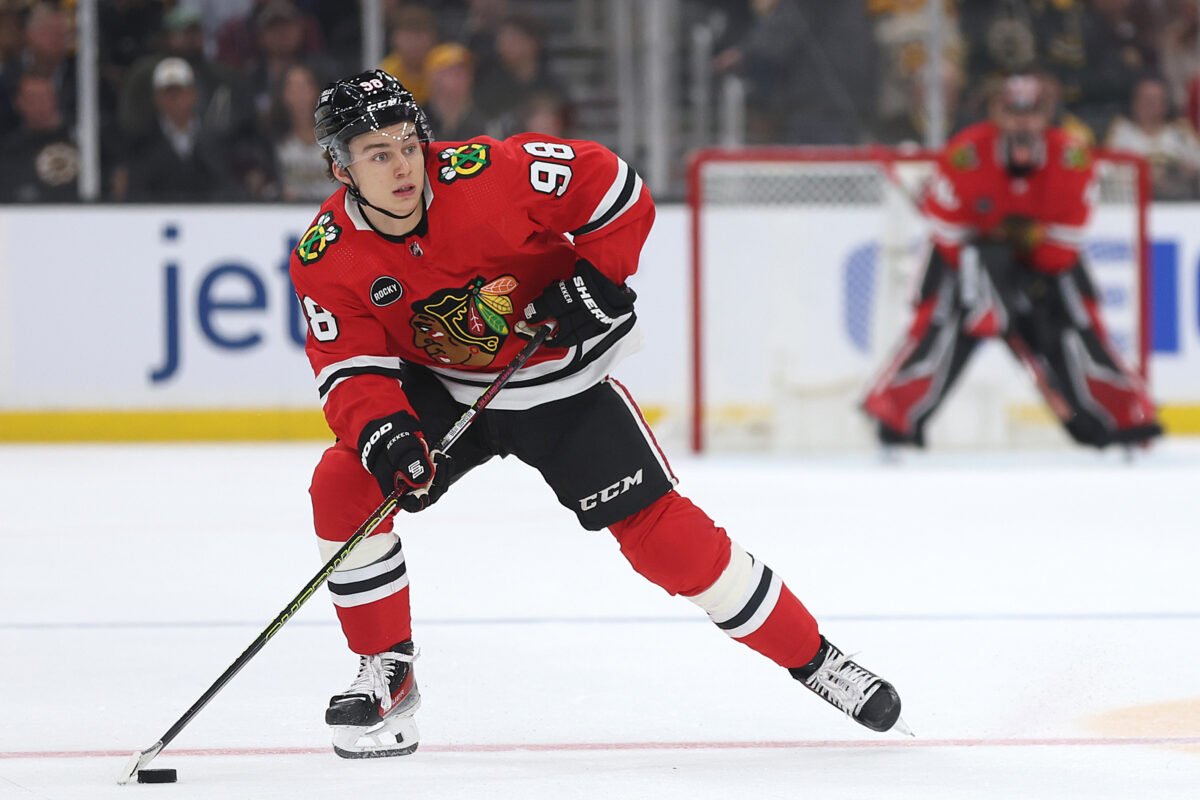The Chicago Blackhawks signaled they were going scorched-earth rebuild hours before last year’s NHL Draft on July 7, 2022. They dealt fan favorite Alex DeBrincat to the Ottawa Senators, landing last year’s seventh (Kevin Korchinski) and 39th (Paul Ludwinski) overall picks in return, along with a 2024 third-rounder. Because of DeBrincat’s age and the fact he was coming off a career season, this move was naturally unpopular among Blackhawks fans.
Related: Blackhawks 2023 NHL Draft Targets: Oliver Moore
A year later, the Blackhawks look better off with this trade than they did when it first went down. Set to become a restricted free agent (RFA), DeBrincat could be on the move again this summer as he’s reportedly headed for arbitration. Meanwhile, Korchinski is one of Chicago’s top prospects and could become part of their next core.
Blackhawks Took a Risk Trading DeBrincat
Compared to Brandon Hagel and Kirby Dach, trading DeBrincat was the riskiest of all three moves by general manager (GM) Kyle Davidson. Not only did DeBrincat finish the 2021-22 season with a career-high 78 points, but he was also the most established of all three players. Had the team kept him (while letting go of Dach and others), DeBrincat would’ve perhaps added a few wins to the Blackhawks’ 2022-23 season but not enough to finish, say, outside the bottom five. The Blackhawks likely would’ve still been in prime position to land a top pick in the 2023 draft, albeit not first overall.
At 24, DeBrincat was young enough that he could’ve been part of Chicago’s next competitive roster. He’ll be 28 come the 2026-27 season, which was a realistic expectation for the Blackhawks to sniff playoff contention a year ago. Granted, drafting Connor Bedard at No. 1 could move that up by a year, but this was a fair goal entering last offseason, knowing the Blackhawks had a pretty weak pipeline up until the 2022 Draft.

Though he regressed in his only season in Ottawa with 66 points, DeBrincat’s generally well-liked and kept a positive attitude even during the Blackhawks’ worst stretches while being a difference-maker on the ice. That’s something you want during a rebuild, no doubt. From a Blackhawks’ perspective, what also made this trade feel risky was the fact they couldn’t land one of Ottawa’s top prospects at the time, such as Jake Sanderson or Ridly Greig.
To some extent, this trade still stings for the Blackhawks. Korchinski took a step forward with the Western Hockey League’s (WHL) Seattle Thunderbirds and could become a future top-pairing defenseman, but that remains to be seen. On the other hand, DeBrincat’s an elite top-six forward. Outside of Lukas Reichel and Bedard, it’s hard to project who among the team’s top forward prospects will pan out. But in hindsight, Davidson is starting to look like he made a reasonable decision by moving on.
Blackhawks Could’ve Kept DeBrincat, But at What Cost?
After just one season with the Senators, DeBrincat wasn’t interested in signing an extension. It’s hard to say whether that would’ve been the case had he stayed in Chicago, but the Blackhawks entered the 2023 offseason with more than $37 million in cap space. Despite requiring a $9 million qualifying offer, they certainly would’ve had the capital to make an extension work.
However, as well-positioned as the Blackhawks are salary cap-wise, an extension would’ve still come with risk. Say the team gave him eight years beginning next season (2023-24), meaning his deal would expire in 2031. Though DeBrincat could very well remain a productive player by that time, ideally, Chicago will have developed its next core with the likes of Bedard, Korchinski, Reichel, and others. Reichel will require an extension next year with his entry-level contract (ELC) expiring. Bedard will need one in 2026.
Related: Blackhawks’ 2023 Free Agent Targets: Defensemen
That doesn’t even include other prospects who may pan out, as well as potential free-agent acquisitions in coming years. Plus, the Blackhawks still have Seth Jones’ deal on the books through 2030, which has an average annual value (AAV) of $9.5 million.
As the Blackhawks get more competitive, Davidson must use his cap space wisely. That was an issue for the last regime, which gave massive deals to Brent Seabrook, Duncan Keith, and Jonathan Toews and consequently had to let go of players who could’ve kept the team competitive for longer, such as Artemi Panarin and Teuvo Teräväinen. DeBrincat may be an All-Star-caliber player, but he’s not an MVP talent. He’s not David Pastrnak or Jason Robertson-like great, and nowhere close to a franchise-changing player such as Bedard.
It’s worth noting the Blackhawks had already tried retooling on the fly, relying on DeBrincat, Hagel, Dominik Kubalik, and other up-and-coming players to help Toews and Patrick Kane chase one last Cup. That strategy didn’t work, and it was time to clear the deck. Though the team could’ve rebuilt around DeBrincat, it’s understandable why Davidson wanted to move on.
Blackhawks Look Better With Trade 1 Year Later
It’d be foolish to declare the Blackhawks winners of this trade just yet. Korchinski looks like he could at least become a solid top-four defenseman, but whether he becomes an All-Star, Norris Trophy-caliber player remains unknown. Fans should be encouraged, however; the 19-year-old had an impressive campaign with the Thunderbirds, tallying 73 points (11 goals, 62 assists) in 54 games with a plus-50. Ludwinski, on the other hand, posted 34 points (nine goals, 25 assists) in 47 games with the Ontario Hockey League’s (OHL) Kingston Frontenacs and could become a high-energy bottom-six forward at the very least.
Obviously, the chance to select Bedard changes everything around the organization. He was arguably the best prospect entering the draft since Connor McDavid (2015) and Auston Matthews (2016) and could be just as good as both players. Yet even if the Blackhawks had landed at second through fifth, they likely would’ve been fine as the 2023 class was exceptionally good. Plus, the Blackhawks will need to build strategically around their future star; McDavid is still chasing his first Cup, while it wasn’t until last year that Matthews finally advanced past the second round. It doesn’t seem likely at this point, but the rebuild could still be a bust.

The Blackhawks didn’t need to move on from DeBrincat. They could’ve integrated him into their long-term plans while still landing a top name in this year’s draft, much like the Arizona Coyotes and Clayton Keller, who isn’t set to hit free agency until 2029. They could always bring him back once they’re competitive as a veteran mentor.
It could be a few more years before there’s a clear winner of this deal. Development isn’t linear, and it may take a few seasons for Korchinski to emerge into an All-Star-caliber player. But with regard to the rebuild, this trade is starting to look like it could pay off the Blackhawks long-term, even though it initially felt off-putting.
